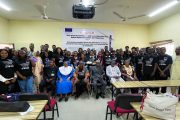Dr Mercy Ette, a former reporter with the now defunct Newswatch but who has since successfully crossed over from journalism into academia has published a journal article implicating the Nigerian media in the marginalisation of women in terms of visibility in politics. Ette who is now a media academic in the Department of Media, Journalism and Film at the University of Huddersfield in the UK came to the conclusion in a paper titled “Where are the Women? Evaluating Visibility of Nigerian Female Politicians in the News Media Space” in the journal Gender, Place & Culture. The article was published October 15th, 2017 in the online version of the journal.
 The outcome of scrutiny of mediated representation of four Nigerian women politicians in The Guardian, The Punch and The Daily Trust between January and April 2015, the author found only 21 stories about the four women selected for attention in the three papers, these being Professor Oluremi Sonaiya, Senator Aisha Alhassan, Senator Helen Esuene and Stella Oduah.
The outcome of scrutiny of mediated representation of four Nigerian women politicians in The Guardian, The Punch and The Daily Trust between January and April 2015, the author found only 21 stories about the four women selected for attention in the three papers, these being Professor Oluremi Sonaiya, Senator Aisha Alhassan, Senator Helen Esuene and Stella Oduah.
Dr Ette provides an interesting background to the women selected: These women contested for presidential, governorship and parliamentary offices. Professor Oluremi Sonaiya was the first woman to win a political party’s nomination to stand as a presidential candidate. As the only female presidential candidate, Sonaiya did not only make political history, she also challenged the view that Nigeria’s socio-economic and cultural heritage did not support the idea of a woman as a leader and that the country is ‘too big, too important in global politics and its place in the twenty-first Century is too great for a woman to cope’, (Newswatch, March 1992).
To find out the visibility of the four women in media spaces, the researcher relied on stories that were published on the websites of the newspapers concerned since back issues of the newspapers were not accessible to her but also in recognition of a growing presence of Nigerian press on the internet as well as the normality of the internet as source of news for sundry users. In this, she also picked only stories that reported the women as candidates and as the subjects rather than general election stories in which the women in question were mentioned only in passing.
In the end, she found only 21 relevant stories about all the four women put together in a study in which the period covered was when coverage of the women should have been at peak. What is more, Prof Sonaiya was relatively invisible in the media as a news subject or source of news, said Ette who described press coverage of her as not even reflective of a honeymoon period following her emergence as her party’s presidential candidate. “In fact, the trajectory of the coverage was flat from the beginning of the race right to the election period”, comments the author and this is despite her being the first female presidential candidate which the author considers a historical achievement.

Dr Mercy Ette
For Dr Ette, stories on her were generally neutral, straight reporting of facts without nuances that could have boosted their stature and prospect. Complaining that when the women were interviewed, they were generally treated as if they were ‘mates’ of the journalists, the author gives the example of how Professor Sonaiya was often addressed as Remi, an affectionate and familiar variant of Oluremi (her first name), a standard that she observes were not applied to Dr Goodluck Jonathan, the presidential candidate of the PDP, for example, by any journalist addressing him as ‘Lucky’ or any journalist referring to General Muhammadu Buhari of the APC as just ‘Mohd’.
Taking this differential treatment as symptomatic of media coverage of women politicians, Ette agrees with researchers who have noted how ‘the trivialisation of women politicians through specific naming strategies can work to constitute a repetitive circuit of disavowal’, with the familiarity questioning the authority and competence of the woman for the office of president. Dr Ette did admit that Prof Sonaiya was running what she calls a hopeless race in the context of the nature of Nigerian political party structure and its traditional Masculinist preference or Sonaiya being the presidential candidate of a small political party that automatically denied her command the attention that candidates of major parties such as the ruling party, the People’s Democratic Party, PDP, and the main opposition party, the All Progressives Congress, APC, took for granted. She, however, concludes that the overall press coverage of the four women significantly limited their visibility in the news media space and undermined their prospect. This, she explains in terms of an assumption that the women were unviable candidates and, therefore, undeserving of media attention.

Prof Oluremi Sonaiya, one of the female contestants in 2015 Presidential poll in Nigeria
Limited visibility is taken as a normatively problematic reality because, according to the study, “it reinforces patriarchal understanding of politics and women’s political participation” and the associated tendency to represent women as powerless and lacking in agency. This is taken up to matter because the media does not just communicate, it constitutes reality, thereby making visibility an issue. But it is not quantitative visibility but the framing or the crafting of the subjectivity of women in opposition to the public space or the space of the state where power is exercised. Mediated representation of women as synonym of the space of home or the domestic space is thus considered by the author and those of the literature she reviewed to be an alienating discourse of women, implicating the media in Masculinist construction of the public sphere. This is considered most objectionable in the Nigerian context where only 3 out of 109 made it as Senators in 1999 in contrast to Rwanda which has chalked up 64%. Hence her preliminary position that the marginalisation of women in the media reflects the patriarchal system that undergirds the country’s socio-cultural and political structures,(p.5).
Dr Ette’s paper does not suffer the fate of such articles published in ‘foreign’ journals in that the work is open access and available to the ordinary reader online. The implication is that it may succeed in drawing the attention of the media establishment, politicians, the political parties and women politicians to the discourse and practice of mediated representation of women and gender equality in Nigeria.





























1 Comments
Deme
Quite an engaging report of the paper.
Good job.